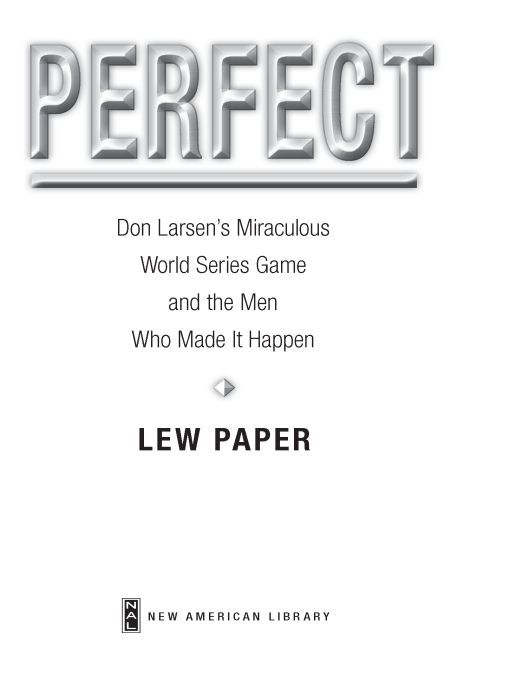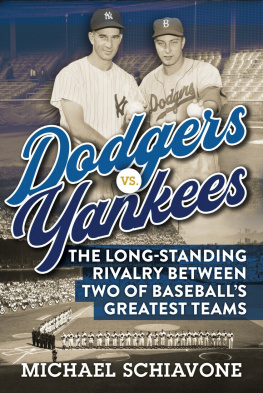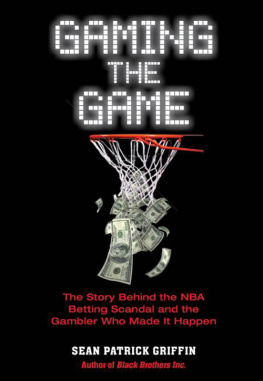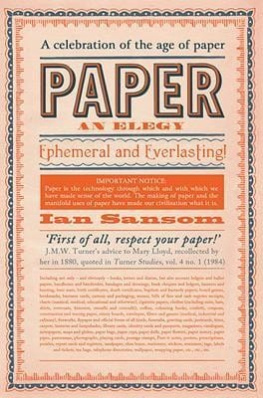Table of Contents
OTHER BOOKS BY LEW PAPER
John F. Kennedy: The Promise and the Performance
Brandeis: An Intimate Biography
Empire: William S. Paley and the Making of CBS
Deadly Risks (a novel)
In memory of my father:
a wonderful man who introduced me to the magic of baseball.
PROLOGUE
The Moment of Truth
The tall right-hander peers down at the catcher from his perch on the pitchers mound under the fading afternoon sun in the cav ernous environs of Yankee Stadium. It is the fifth game of the 1956 World Series, and the soaring facades of the stadium cast a giant shadow over much of the field while a slight breeze blows against the flags in the outfield. It is a relatively warm day with only a hint of autumn in the air, and a thunderous noise is sweeping through the 64,519 fans in attendance, almost all of whom are now standing in anticipation of witnessing a miracle in baseball history.
Yogi Berra, the Yankees perennial All-Star catcher, looks up at Don Larsen from his crouch. Larsens ears protrude from his cap and explain the nickname that has followed him everywhere: Gooney Bird. It seems to fit Larsen perfectly: an almost pear-shaped body draped on a six-foot-four-inch frame with long, dangling arms.
None of that is on Berras mind now. His heart is pounding and his eardrums are throbbing with the roar of the crowd as he focuses on the next pitch. He cannot lose his concentration. He has called each pitch that Larsen has already thrown against the Brooklyn Dodgers that day. All ninety-six of them. And no one can have any reason to second-guess the burly catcher. Twenty-six Dodger batters have come to the plate, and twenty-six Dodgers have made an out.
Over the course of thousands of major-league baseball games that have been played in the twentieth century up to this point, there have been only four perfect games in which no batter reached base. The last one was pitched by Charlie Robertson for the Chicago White Sox thirty-four years ago in 1922. To be sure, there have been more than one hundred no-hitters marred by a walk, a fielding error, or some other circumstance that allowed a batter to reach base. But there has never been a no-hitter in a World Series. And never before has a pitcher come so close to pitching a perfect game in a World Series. Only one more out separates Larsenan otherwise mediocre pitcherfrom an immortality that has eluded baseballs most illustrious pitchers.
This is a new experience for Larsen. But not for Berra. In October 1947, Bill Bevens, another second-rate Yankee pitcher, stood on the same threshold of baseball immortality in the fourth game of the World Series against the Dodgers in Ebbets Field. Like Larsen, he took a no-hit game into the ninth inning and then got the first two men out. But that was not a perfect game. Far from it. Bevens had given up ten walksa World Series record. One run had scored, and the Yankees had a 2-1 lead. Two men were on basethe result of walks. Still, the Yankee pitcher had only to get one more out to do what no other pitcher had done in World Series playpitch a no-hitter. But Cookie Lavagetto, the Dodgers aging third baseman, slammed a Bevens pitch against the right-field wall for a double and two runs, turning a near-miraculous pitching performance into a 3-2 Yankee defeat.
The memory of that loss looms large in Berras mind because the Yankees are winning by a score of only 2-0. Anything can happen, he remembers thinking. Yankee manager Casey Stengel understands the risk as well, and he has Yankee ace Whitey Ford warming up in the bullpen if Larsen should falter. Still, Berra has hopes that Larsen can do what Bevens could not. Not only for Larsens sake but for the teams as well. I wanted to win the game, Berra later said. Thats what I wanted to do.
For all his contribution in calling the specific pitches, Berra knows that much of the credit has to go to Larsen. The twenty-seven-year-old pitcher from Michigan City, Indiana, has demonstrated pinpoint control with a no-windup delivery that has baffled the Dodger batters. They are used to the big deliveries that virtually all pitchers of the day use and that give the batter time to adjust for the tiny ball that comes hurtling toward them at speeds up to ninety-eight miles an hour. As Berra would later say of Larsens contrasting approach, The ball just kinda came out of nowhere.
Larsen had first experimented with the no-windup delivery toward the end of the 1956 season. It was not an idle experiment. In a game against the Boston Red Sox, Larsen became convinced that Del Baker, the Red Sox third-base coach, was able to identify the kind of pitch Larsen was about to throw by watching his delivery. Larsen assumed that other team coaches were also stealing his signs and thwarting his success, and he was determined to do something about it. He asked Yankee pitching coach Jim Turner if he could use a no-windup delivery in his next outing. Turner chuckled at the proposal but said he didnt mind.
The impact was immediateand favorable. Larsen pitched the Yankees to four victories in the final pennant drive in September, boosting his won-lost record from a pedestrian 7-5 to an impressive 11-5. The Red Soxs Ted Williams, perhaps the greatest hitter of Larsens generation, was among those who noticed the difference in Larsens performance. The guy that kills me, Williams would later admit, is Larsen. I cant hit that son of a bitch. Hes standing there like a statue. Hardly any motion. And then the balls on you.
Although teammate Bob Turley also began using it at about the same time to gain more control and reduce walks, Larsen said he could never remember where he got the idea for the no-windup delivery. When a sportswriter asked him for the source of his new delivery, Larsenan avid reader of comic booksresponded that the comic book ghoulies sent me the message to try it.
Larsens late-season success with the no-windup delivery earned him the opportunity to start the second game of the 1956 World Series at Ebbets Field. However, the experience fell far short of his expectations. Although he thought he had excellent stuff that day, Larsens control was anything but pinpoint. Before the second inning was over, he had walked four men and given up a hit. The Yankees appeared to be in danger of losing a 6-1 lead, and Casey Stengel, the sixty-six-year-old Yankee manager with a bowlegged walk, had waddled out to the mound to replace the Indiana native.
Larsen was angry at Stengel for taking him out of the game. After all, he had given up only one hit and the Yankees still had a comfortable lead. He stormed off the mound and made no secret of his feelings when he reached the dugout. I dont give a damn if I ever pitch a game for the Yankees or Stengel again, he told his teammates. Later he was more philosophical about it. Casey Stengel, he observed, always said that when a pitcher doesnt have control, hes pitching to the hitters strengths. But after that second game, Larsen knewor at least thought he knewthat his pitching chores in the 1956 World Series were over. Stengel, Larsen assumed, was not about to take another chance on a pitcher who had shown the wildness that Larsen had displayed in those two innings. The World Series was too important.
Making assumptions about Stengels strategy, however, was always risky business. The man was unpredictable. And, in time, nowhere would that unpredictability be more evident than in Stengels selection of a pitcher for the pivotal fifth game of the series at Yankee Stadium on Monday, October 8. Each team had won two games, and Stengels choice for the Yankee starting pitcher had to be someone who could inspire confidence among his teammates. Don Larsen hardly seemed to be the right candidate.
















